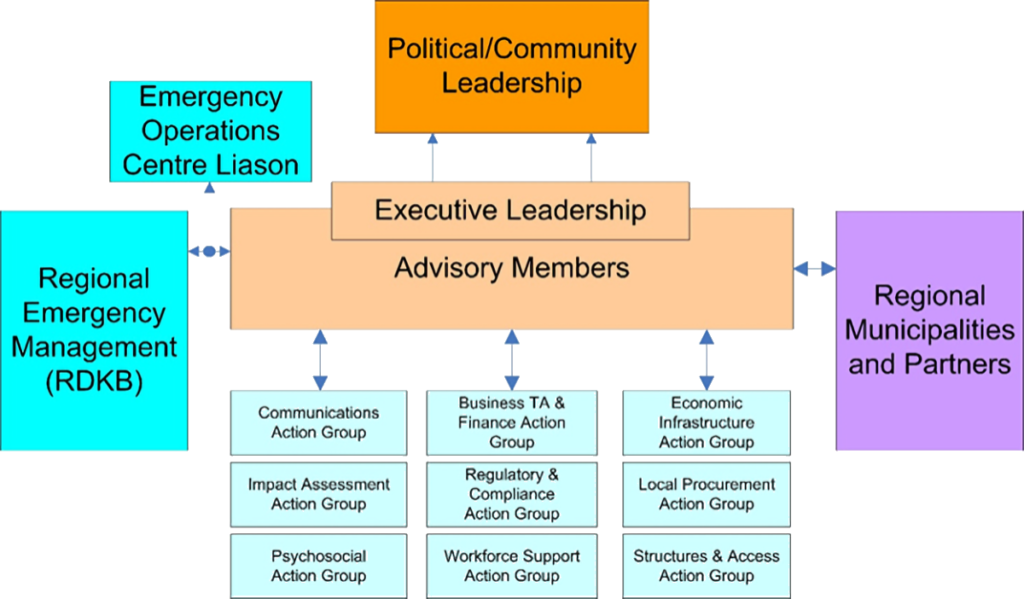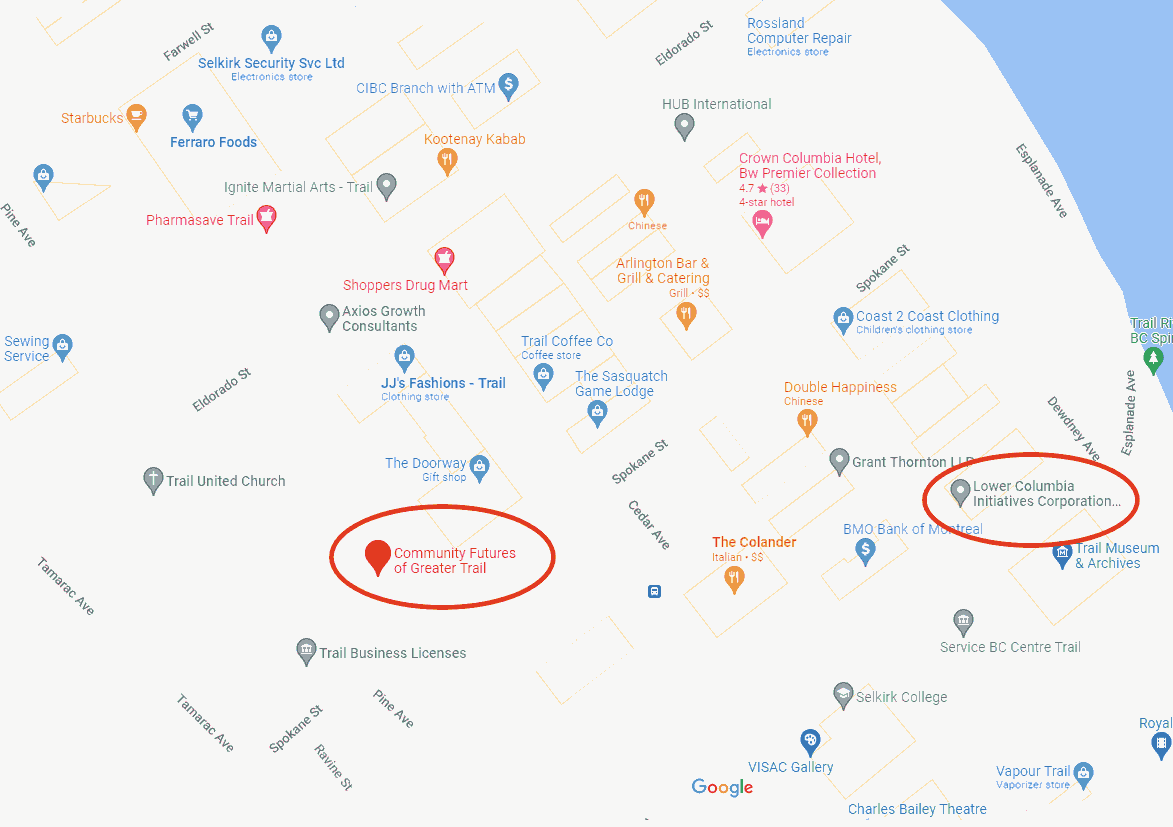ERAP Governance and Activation
Table of Page Contents
Leadership Structure
The ERAP is managed by the Economic Resilience Action Plan Committees (ERAP Committees), which is composed of local economic leaders, workforce leaders, business owners, emergency management organizations, representatives of vulnerable populations, and other relevant stakeholders. The ERAP Committees are responsible for the following overall functions:
- Maintaining the plan and coordinating stakeholder participation.
- Implementing the plan and standing up Economic Resilience Action Groups as necessary during times of economic disruption.
- Promoting business and economic resilience practices during non-emergency times.
- Liaising with regional emergency management organizations, as well as regional municipalities and partners, to coordinate economic resiliency efforts.
- Reporting to political and community leaders on economic resilience and coordinating economic response/recovery with those leaders during emergencies.
The general committee structure and its relations to external partners and agencies is shown below.

Roles and General Responsibilities
The ERAP Committee, its partners, and relevant agencies all have various roles to play in economic resilience. For the City of Trail and Region, those roles, general responsibilities, and assigned organizations are indicated below.
Many of the organizations listed in this document may have roles to play in several action groups in the event of an emergency, and their areas of responsibility will include their defined action groups, possibly supporting related but separate actions groups, supporting overall general incident response through the EOC, and supporting their own day-to-day operations and business continuity needs.
Executive Leadership
General Responsibilities
Assigned Organizations
The Executive Leadership of the ERAP Committee leads planning efforts and is the first point of contact for activating the plan in times of economic disruption. General responsibilities include:
- Convening Advisory Members for plan development, revisions, etc.
- Identifying occasions for activation and activating the ERAP, including activating Action Groups as necessary.
- Standing up the Business Emergency Operations Centre (BEOC) as necessary.
- Directing the development of Incident-Specific Economic Recovery Plans.
- Providing an Economic Liaison to the incident Emergency Operations Centre (EOC) as necessary, as well as to ongoing emergency management planning sessions and programs.
- Advising key stakeholders, including Political and Community Leadership, on situation specifics and best practices.
- Coordinating high-level financing of economic resilience activities, as necessary.
- Coordinating mutual aid agreements with Regional Municipalities and Partners.
- Exercising the ERAP as necessary.
- Reminding Economic Resilience Action Group (AGs) members and leaders to get the work done.
Community Futures South Kootenay (CFSK)
- Erik Kalacis
- Loro Seymour
Regional District Kootenay Boundary (RDKB)
- Mark Stephens – Manager of Emergency Programs.
Clear Sky Consulting
- Chris Marsh
Lower Columbia Initiatives Corporation (LCIC)
- Rebecca Richards
Trail and District Chamber of Commerce
- Erika Krest
Advisory Members
General Responsibilities
Assigned Organizations
Advisory Members of the ERAP Committee are representatives of the local economy, workforce, businesses, emergency management, vulnerable populations, and other relevant stakeholders. The Advisory Members are responsible for:
- Supporting Executive Leadership in developing, revising, and executing the ERAP.
- Providing guidance on activating the ERAP during atypical disruptions.
- Leading Economic Resilience Action Groups.
- Coordinating resources and community support from their own constituencies, funders, etc.
- Leaders from each of the 9 Economic Resilience Action Groups (AGs)
- RDKB Board of Directors
- East End 7 Elected Officials (reps from Rossland, Warfield, Trail, Montrose, Fruitvale and RDKB Electoral Areas A and B)
Economic Resilience Action Groups
General Responsibilities
Assigned Organizations
The Economic Resilience Action Groups (AGs) are responsible for individual functions within overall economic resilience. Each AG is tasked with a specific area of resilience, and manages the activities related to that area in all phases of emergency management. General responsibilities include:
- Identifying roles and responsibilities within the AG action area, including activities during all phases of emergency management.
- Coordinating staff and resources for the AG during all phases of emergency management (with the support of Executive Leadership and Advisory Members).
- Managing AG responsibilities during all phases of emergency management.
- At the direction of Executive Leadership, standing up the AG during incidents and implementing the AG plans.
Reporting on AG activities, needs, and goals to Executive Leadership and Advisory Members as required.
Action Group Leaders:
1. Business TA & Finance AG
Community Futures South Kootenay & Basin Bus. Advisors
- Erik Kalacis
2. Communications AG
Community Futures South Kootenay
- Ron Perepolkin
- Erik Kalacis
3. Economic Infrastructure AG
- Local Government – Public Works Dept. or RDKB
4. Impact Assessment AG
- Lower Columbia Initiatives Corporation
- Short-term – LCIC
- Long-term – RDI at Selkirk (TBD)
5. Local Procurement AG
- Trail and District Chamber of Commerce and Community Futures South Kootenay
- Erika Krest / Loro Seymour
6. Psychosocial AG
- Interior Health Authority, Salvation Army
- TBD
7. Regulatory & Compliance AG
- Local Government or RDKB
- TBD
8. Structures & Access AG
Clear Sky Consulting Ltd.
- Chris Marsh
9. Workforce Support AG
WorkBC
- Savina Kelly (TBD)
Political and Community Leadership
General Responsibilities
Assigned Organizations
Political and Community Leaders act as a layer of accountability and support for the ERAP Committee and may also serve in various implementation roles. General responsibilities include:
- Developing and maintaining regulatory statues or other enabling policies that authorize the work of the ERAP Committee, as necessary.
- Motivating community support for, and attracting resources to, the work of the ERAP Committee.
- Coordinating incident-level economic responses and communications with the Executive Leadership of the ERAP Committee and following their advice when possible.
- Identifying occasions for activating the ERAP and making recommendations to the ERAP Committee, as necessary.
- Evaluating the performance of the ERAP Committee and providing feedback or recommendations, as necessary.
- RDKB Board of Directors
- East End 7 Elected Officials (representatives from Rossland, Warfield, Trail, Montrose, Fruitvale and RDKB Electoral Areas A and B)
Regional Emergency Management
General Responsibilities
Assigned Organizations
Regional Emergency Management organizations are the leads in preparing for, responding to, and recovering from, many (but not all) hazards that cause economic disruption. In the cases of disasters that fall under the BC Emergency Management System, Regional Emergency Management organizations are the primary partners for coordinating all phases of emergency management. For the purposes of the ERAP, the general responsibilities of Regional Emergency Management organizations include:
- Integrating an Economic Liaison into all phases of emergency management planning and implementation, as necessary.
- Providing incident-level information and support when possible.
- Coordinating communications with the ERAP Communications AG when economic impacts are present.
- Exercising emergency management plans in coordination with exercising the ERAP, as appropriate.
- Financing ERAP Committee operations when possible, under the Emergency Program Act.
Regional District Kootenay Boundary Emergency Management Program
- Mark Stephens
- Carlene Pires
Regional Municipalities and Partners
General Responsibilities
Assigned Organizations
Regional integration and support is necessary for the resilience of any regional municipality or community, as well as the resilience of the region as a whole. In many cases support will be necessary from adjacent communities, and Trail and Region will also be able to provide support to those communities as well. There may also be external partners on whom Trail, and the local region may rely upon in times of need for economic resilience support. Responsibilities of each municipality or partner is determined on a case-by-case basis, but in general they may include:
- Providing resources and capacity when gaps exist during Trail and Region-area incidents.
- Calling upon Trail and Region in times of need.
- Maintaining a collaborative network of economic resilience practitioners to coordinate regional plans and economic resilience activities.
- City of Trail
- Village of Warfield
- City of Rossland
- Village of Montrose
- Town of Fruitvale
- Regional District Kootenay Boundary
- BCEDA, SFU CED
Activating the ERAP
- Any time an Emergency Operations Center (EOC) is activated for Trail and Region, the ERAP Executive Leadership will immediately activate the plan.
- In some cases of economic disruption, there will be no EOC activated. In these cases, the ERAP Advisory Members, Political and Community Leaders, or other members of the community may request that the ERAP Committee meet and decide to activate the plan. In such cases the Executive Leadership and Advisory Members will decide together whether activation is necessary.
- When the ERAP is activated, the Executive Leadership will identify and stand up the Action Groups that are necessary.
- As an incident concludes, or recovery resources are exhausted, the Executive Leadership will demobilize Action Groups (with input from Advisory Members).
- As a whole, the ERAP Executive Leadership and Advisory Members will deactivate the plan.
- The Executive Leadership committee should make contact early in the event with the following organizations to ensure support is being considered and external agencies are able to aid where necessary and possible:
- Regional Economic Operations Branch, Ministry of Forests, Lands, Natural Resource Operations and Rural Development – Larry Olson, Regional Manager
- British Columbia Economic Development Association (BCEDA) – Dale Wheeldon, President
- RDKB Emergency Operations Centre or Emergency Management Program – Mark Stephens, Manager of Emergency Programs
Developing Incident-Specific Economic Recovery Plans
As noted above, major incidents will usually require incident-specific response and recovery plans that identify the long-term strategies, activities, programs, and other logistics for sustaining through, and recovering the economy from disruption. These plans are separate, stand-alone documents that are developed after the disruption occurs and is based on available information and projections at the time. They may be developed internally by ERAP Committee staff or may be developed externally by contractors secured by the ERAP Committee.
In cases of major economic disruption, the following protocols will be observed:
- The Executive Leadership and Advisory Members will determine if a recovery plan is needed and will identify if an external contractor is necessary to draft it.
- The Executive Leadership will work with relevant agencies and funders to secure resources necessary to develop the plan.
- The Executive Leadership and Advisory Members will support the development of the plan with information, interviews, etc., to ensure that the plan is both comprehensive and achievable.
Activating the Business Emergency Operations Centre (BEOC)
A Business Emergency Operations Centre (BEOC) is usually set up during an incident of economic disruption to serve as a coordinating center for plan leadership and implementation. Executive Leadership, AG Leads, relevant Advisory Members, and support staff may work directly from the BEOC and/or meet regularly at the BEOC to coordinate efforts. The BEOC may also be virtual, with representatives working remotely, but connected using digital tools such as Skype, MS Teams, Zoom, cloud networks, and others.
The BEOC may also host or serve as an Intake Centre for businesses seeking assistance during economic disruption. Various forms of technical assistance and other supports may be provided from the Intake Centre during the economic recovery. The BEOC and the Intake Centre may be housed at the same site or different sites.
Note that the BEOC may transition for more of a Business Resiliency Centre once the initial emergency has passed, and businesses are seeking more recovery support than emergency response support.
The protocol for activating and deactivating the BEOC is as follows:
- The Executive Leadership will decide if an incident warrants a BEOC and will stand one up as necessary.
- As an incident concludes, or recovery resources are exhausted, the Executive Leadership will deactivate the BEOC (with input from Advisory Members).
The locations identified for the Trail and Region BEOC include:
- Primary Location: Community Future South Kootenay Office
- Backup Location in Trail: Lower Columbia Initiatives Corporation office
Other potential backup locations:
- Community Futures Boundary, Grand Forks
- Lease space at Waneta Plaza (Outside of downtown core)
- Online: Establishment of a virtual BEOC is possible, would benefit from advanced planning and development.
BEOC Locations


